* Press release…
New copays and coinsurance for existing enrollees in the Health Benefits for Immigrant Seniors (HBIS) and Health Benefits for Immigrant Adults (HBIA) programs will go into effect on Feb. 1, as the Department of Healthcare and Family Services (HFS) previously announced.
Most services covered by the HBIA and HBIS programs, which provide health care coverage for individuals who would be eligible for Medicaid coverage if not for their immigration status, will continue to be free for customers, including primary care visits, prescription medications and vaccinations at a pharmacy or doctor’s office. The new copays and co-insurance will apply to the use of non-emergency hospital or surgical center services, like nonemergent elective surgeries, physical therapy and lab work.
Copays are fixed amounts paid for health care services covered by a health plan, while coinsurance is a type of cost-sharing where a customer pays a percentage of the total price for a covered health care service, and their insurer pays the remainder. Both copays and coinsurance are common cost-sharing practices used in both commercial insurance and in Medicare. Enrollees should always check with their provider on whether they will be charged out-of-pocket costs for a service.
The impact of copays and cost-sharing will vary for participants based on their enrollment in Medicaid Managed Care, which many HBIA and HBIS participants will be transitioning to over the next several months. The copays and coinsurance and the transition to managed care for HBIA and HBIS enrollees are among the cost-saving measures HFS has implemented in order to bring program costs within the budgeted amount for State Fiscal Year 2024.
For those already enrolled or in the process of enrolling in a Managed Care Organization (MCO), out-of-pocket costs will depend on the MCO. Some MCOs are waiving all or some of the allowable charges, which means hospitals or surgical centers will not charge members of that MCO an out-of-pocket cost for some or all non-emergency procedures and services. Those not enrolled in an MCO can be charged copayments or coinsurance.
No copay or cost-sharing may be charged for an emergency service needed to evaluate or stabilize an emergency medical condition, which is a condition with symptoms severe and painful enough that a reasonable person would think they are life-threatening and need immediate medical care. Individuals who have severe symptoms that could be life threatening should not hesitate to seek immediate treatment, and in those instances will not have cost sharing requirements.
Copays and cost-sharing may only be charged on the following services:
• Non-emergency Inpatient hospitalizations: $250 copayment per stay.
• Non-emergency Hospital Outpatient Services or Ambulatory Surgical Treatment Center: 10% of what HFS would pay the provider. The amount an enrollee can be charged will vary depending on the service and the provider, and enrollees should check with the provider on whether they will need to pay an out-of-pocket cost for a service.
HFS has removed a previously planned $100 copay for non-emergency hospital ER services, after consulting with the Centers for Medicare & Medicaid Services and confirming that the state can seek reimbursement for all emergency room care. In addition, some of the MCOs are waiving copays for certain service types: CountyCare, which only serves customers in Cook County and will serve the majority of HBIA and HBIS enrollees, is waiving all copays and coinsurance for HBIA and HBIS customers.
Beginning January 1, 2024, many HBIA and HBIS customers have begun receiving services through HealthChoice Illinois, the State of Illinois’ Medicaid Managed Care Program. Previously, services were delivered to HBIA and HBIS customers solely via a fee-for-service model. The shift to managed care provides a level of care coordination for customers that isn’t available with fee-for-service. Care coordinators help customers connect with the medical care and social services they need.
MCO enrollment for HBIA and HBIS customers is taking place in waves, with the last cohort of HBIA and HBIS customers enrolling with an MCO April 1. HBIA and HBIS customers are receiving enrollment packets in the mail that explain the transition to managed care and what they need to do. A sample MCO enrollment letter is available here.
HBIA and HBIS enrollees who have comprehensive private insurance or spenddown will remain in fee-for-service and will not enroll with a managed care plan or receive an MCO enrollment mailing.
More information about the HBIA and HBIS transition to managed care is available here.
*** UPDATE *** Healthy Illinois Campaign…
Today, the Illinois Department of Healthcare and Family Services (HFS) will implement co-payments and co-insurance for some nonemergency services for enrollees in the State’s Health Benefits for Immigrant Adults (HBIA) and Health Benefits for Immigrant Seniors (HBIS) programs. Yesterday, HFS announced it would no longer go forward with the implementation of co-pays for emergency services. Healthy Illinois Campaign Director Tovia Siegel released the following statement in response to the announcement:
“Healthy Illinois Campaign is pleased the Illinois Department of Healthcare and Family Services announced they will no longer be instituting co-pays for some emergency room visits. This decision will keep Illinoisans safer and allow them to seek the healthcare they need in emergencies.
“However, the two co-payments that will go into effect on February 1 will place a significant burden on both providers and patients, limiting access to healthcare for Illinois’ immigrant community. We urge the Department of Healthcare and Family Services and Managed Care Organizations to reconsider implementing these charges, which will generate a relatively small amount of money but can be the difference between life and death for low-income Illinoisans.
“Healthy Illinois Campaign stands ready to work with HFS and the Governor’s Office to find fiscally responsible and sustainable ways to ensure equitable access to health care for the state’s lowest-income residents.”
7 Comments  
|
Question of the day
Wednesday, Jan 31, 2024 - Posted by Rich Miller
* Interesting…
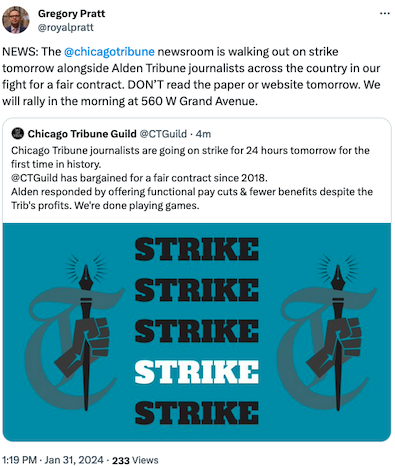
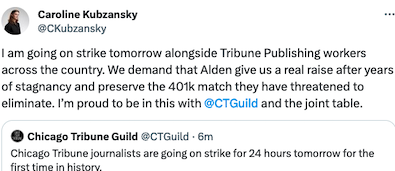
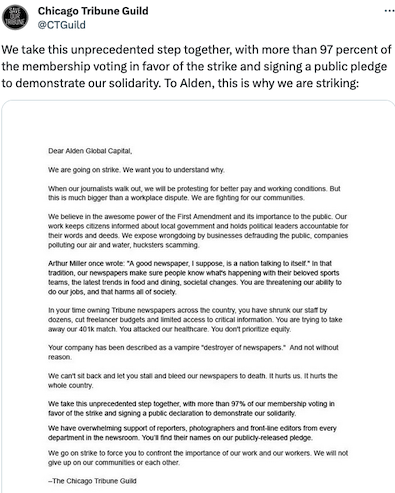
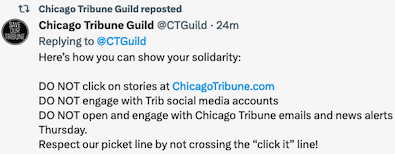
What I’m proposing here is an advisory-only referendum because I wanted to get your thoughts, but I am reserving the right to make the final decision myself.
* The Question: Should CapitolFax.com honor the Chicago Tribune Guild’s picket line tomorrow and not post any stories from the paper? Take the poll and then explain your answer in comments, please. Thanks.
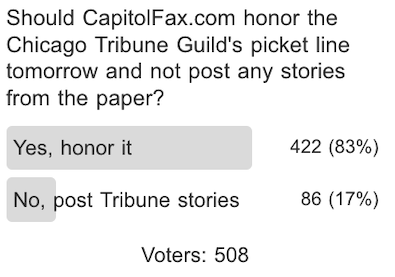
…Adding… The poll is now closed.
64 Comments  
|
|
Comments Off  
|
Live coverage
Wednesday, Jan 31, 2024 - Posted by Rich Miller
* You can click here or here to follow breaking news because, as I initially suspected, the widget we’ve been using didn’t last long.
Comments Off  
|
Live coverage
Tuesday, Jan 30, 2024 - Posted by Rich Miller
* You can click here or here to follow breaking news because, as I initially suspected, the widget we had been using didn’t last long.
Comments Off  
|
* My weekly syndicated newspaper column…
Chicago Mayor Brandon Johnson’s budget that he passed last November deliberately underfunded programs for asylum-seekers. The meager appropriation could be exhausted by April, but nobody knows yet what the city plans to do when it reaches that point.
Also last November, Gov. J.B. Pritzker made it clear to reporters “the state doesn’t run shelters” and said he was waiting for the city to recommend shelter sites. “The state doesn’t control property in the city of Chicago that could provide a location. The city really has to do that.”
Pritzker also criticized the city for not asking the General Assembly for additional money and noted, “We have spent much more money to support the system of asylum-seekers arriving here than the city has.”
In December, the state declined to fund a huge, 2,000-bed tent shelter in the city’s Brighton Park neighborhood after an evaluation of a city contractor’s report by the Illinois Environmental Protection Agency found the remediation completed by the city “did not meet IEPA standards to receive [a formal letter stating no more mediation was needed] and was therefore not approved,” an IEPA spokesperson reiterated last week.
The city was furious at the denial, and Johnson complained to reporters again last week that the state still has not fulfilled its promise to open those 2,000 new beds. The state claimed then and has ever since then that, despite repeated requests, the city has not yet offered up any more sites. Johnson told reporters this was not true. I’m still checking on this.
Also in December, Johnson announced a program to ticket and even impound buses carrying migrants to the city from Texas unless drivers followed rules for when and where their passengers could be dropped off.
That quickly had the effect of forcing the bus companies to dump people in the suburbs and exurbs, where they are then directed to public transportation to Chicago. During the week ending Jan. 19, not a single bus from Texas arrived directly in Chicago, according to a document released to city officials.
Mayor’s no longer very welcoming
The city has opened no new migrant shelters since November, although Chicago officials made it appear as if they were still working on plans to do so in December, specifically a shelter on the city’s Northwest Side at a site owned by the Catholic Archdiocese. Will Chicago still open and operate that shelter? No. But the city has been hoping the state and/or the Archdiocese could open it, and now I’m hearing the shelter might possibly go forward.
On Jan. 12, city officials went even further and told state legislators the city had “begun planning for rightsizing” its shelter system. That’s corporate-speak for “downsizing,” although a city official now says they probably shouldn’t have used that word.
And then last week, Johnson told reporters the state government “can build a shelter anywhere in the state of Illinois,” adding the state “does not have to build a shelter in Chicago.”
This, of course, ignores the fact the migrants’ stated preference is a Chicago destination. More importantly, it’s also the politically targeted destination set by the Texas governor. In other words, the mayor can say what he wants, but they’re coming regardless.
His comment also ignores the fact the state has spent hundreds of millions of dollars on infrastructure and caring for asylum-seekers in Chicago. Expanding that out would be prohibitively expensive and disperse scarce human resources.
There are only so many people who are willing to do the work and qualified to do it. Dispersing those workers throughout a large geographic area would make their task a lot tougher. It may be unfair to the city, but that’s where the infrastructure is.
Not to mention that suburban mayors aren’t exactly falling all over themselves to take any of these folks in. When a reporter asked Cook County Board President Toni Preckwinkle last week if any suburban mayors had taken up her offer to open shelters, Preckwinkle said, “Those conversations didn’t result in offers of assistance.”
It’s becoming more clear almost every day that, despite his initial promises to welcome the new arrivals with open arms and share with them the city’s “abundance,” Johnson’s aim for weeks if not months has been to pull back from the task of accepting and caring for the continuing influx of asylum-seekers and return to his progressive agenda, like banning natural gas connections in most new construction.
Meanwhile, April gets closer every day.
* A few hours after I wrote that column, this story was published by Nadig Newspapers…
Plans are moving forward for a migrant shelter at the former Saint Bartholomew school and convent in Portage Park, while another former parochial school in the 30th Ward would be converted into 24 apartments, said Alderwoman Ruth Cruz. […]
Officials have said that 300 to 350 people would be housed on the site.
It’s unclear from the story what entity will actually be responsible for opening and operating the shelter, but I was told by a top city official late last week that it wouldn’t likely be them.
*** UPDATE *** Gov. Pritzker was asked today to respond to Mayor Johnson’s statement that the state doesn’t have to build more shelters in Chicago…
Well, it’s unfortunate that the governor of Texas is sending thousands of migrants to the city of Chicago. That is where they think they’re going, that is where they expect to be arriving. Not in Elmhurst, not in other suburbs, but in the city of Chicago.
It is also where all the services are that they need when they arrive. It is also where the major landing zone that we’ve paid for, to make sure that we’re welcoming them as appropriate to the city. And frankly, the city has a shelter system like none other.
So all I would say is that we certainly have encouraged other jurisdictions to step forward. We’ve created grant programs. Some of them have taken us up, Oak Park, for example. And we’re providing resources for other jurisdictions. So that is happening, there is shelter and services.
But the major and majority part of what’s necessary needs to be in the city of Chicago. And we have been supporting the city of Chicago with literally tens of millions of dollars directly as well as hundreds of millions of dollars indirectly.
19 Comments  
|
Live coverage
Monday, Jan 29, 2024 - Posted by Rich Miller
* You can click here or here to follow breaking news because, as I initially suspected, that widget we were using didn’t last long.
Comments Off  
|
* City of Chicago…
Today, the City of Chicago and the Department of Family and Support Services (DFSS) are announcing the conclusion of the Request for Proposals (RFP) process to find a new food service provider for city-run shelters for New Arrivals. DFSS is pleased to announce that two local agencies, Seventy-Seven Communities and 14 Parish, were selected.
Seventy-Seven Communities will serve as the food provider for shelters in the North Region of Chicago and 14 Parish will serve as the food provider for the New Arrivals shelters in the South Region.
* Block Club Chicago…
Seventy-Seven Communities is a suburban-based company created in October, according to state filings. It’s run by leaders at the popular and rapidly expanding Italian beef franchise Buona Beef as well as its sister company, Beyond Catering.
Seventy-Seven Communities’ executive director is listed as Joe Buonavolanto Jr., one of the sons of Buona Beef’s founders and an owner of Buona Beef, LLC, according to state filings. Mike Iovinelli, program director of Seventy-Seven Communities, is also listed as vice president of catering at Beyond Catering — whose parent company is Buona Beef.
The city’s press release did not mention Buona Beef or Beyond Catering. Officials said Seventy-Seven Communities had “decades” of experience in food service, even though records show the company has only existed for four months. It does not appear to have a website.
* Back to the city’s press release…
The goals of this RFP were to increase food quality for all New Arrivals shelters and to decrease the cost of the Meals Program for the City. Both Seventy-Seven Communities and 14 Parish have demonstrated that they can provide high quality and culturally congruent meal service to all shelters for $15-$17 per person per day. This is a significant decrease from the $21-$23 the City has been spending on food per person per day prior to this contract. Additionally, both agencies have demonstrated that they have many partnerships with local and minority-owned restaurants, including local Venezuelan restaurants, who will be assisting in creating menus and preparing food that fit both the nutritious and cultural needs of shelter residents.
* NBC 5…
Through these new vendors, the city of Chicago reported that the new direction in food servicing is proving to be cost efficient. The new price the city will pay for providing to the shelters is $15-17 per person. Prior to the new contract the price per person was $21-$23 with Greater Chicago Food Depository and Open Kitchens.
* The Greater Chicago Food Depository was the previous vendor. I reached out for comment today. A spokesperson noted that 1) The state government and private donors, not the city, paid for the meals; 2) Because of the private donations, the actual costs were well below the price claimed by the city; and 3) It was working with 17 minority-owned food businesses…
The Food Depository has never received any funding from the City of Chicago for our work over the last 8 months to provide food for new arrivals at their shelters, so the implication that we produced meals at a rate of $21-$23/person using City funding is wholly inaccurate.
The Food Depository’s work to provide meals at new arrival shelters was supported by private donors and funding from the State of Illinois. This detail is important for us to clarify as we have a responsibility to our donors and the state who gave generously to support this important work to know that their contributions were utilized responsibly.
Our price per meal was far more efficient than what is quoted in the City’s release and every dollar we spent on new arrival meals went toward food costs, with $17 million invested in local restaurants and caterers who partnered with us in this work. We essentially paid 17 minority-owned food businesses to prepare and deliver the meals as a way of supporting food vendors in historically disinvested communities.
…Adding… The city says its dig was at a different vendor, not at the Food Depository. NBC 5 reported this week that the Food Depository was one of the two vendors.
4 Comments  
|
Getting into the weeds of an outdated report
Friday, Jan 26, 2024 - Posted by Rich Miller
* This article from Capitol News Illinois stirred up some controversy…
State law currently says that by the 2025 delivery year, one-quarter of electricity purchased by the state must come from renewable sources. Goals laid out in CEJA are even more ambitious, requiring the state’s energy production to be carbon-free by 2045.
But the Illinois Power Agency – which handles energy procurement for the state’s utilities – reports that the state is lagging far behind its goals. In its current long-term plan for renewable purchasing, which was published in May, the agency projected that by the 2025 delivery year, only 8.1 percent of electricity will come from sources that qualify as renewable under state law.
“Achieving these goals would require a substantial increase in new renewable energy generation,” according to the agency’s report.
The federal Energy Information Administration, which uses a slightly different method to calculate its figures, reports that 15.4 percent of Illinois’ electricity generation came from renewables in October. That lags the state’s statutory goal for this year of 22 percent and behind the nation’s average renewable electricity generation of 22.3 percent.
* The governor’s spokesperson Jordan Abudayyeh, tweeted in response, “IL isn’t behind in our energy goals and I wouldn’t use a report from May of last year to make that point. … Carbon-free is different than renewable energy and IL will rely heavily on nuclear to reach our carbon-free goals.”
Carbon-free is hugely important in the mix because the state gets more than half of its electrical power from nuclear plants.
* Since numbers from the Illinois Power Agency were used in the news story, I reached out to the agency to get their perspective…
Hi Rich,
We were not contacted by CNI on this story, so we can’t speak authoritatively on from where CNI pulled this information. It’s possible that the “May report” in the article refers to the Modified 2022 Long-Term Renewables Procurement Plan, but RPS [Renewable Portfolio Standards] goal/target data contained is indeed approximately two years outdated (as that Plan was originally filed with the ICC in January 2022). So, assuming that CNI used this document to inform its article, the Governor’s Office is correct that this information is outdated.
To the broader question, our 2022 Annual Report includes data on the overall nameplate capacity amount of installed renewable energy generation physically located in Illinois. The 2022 Annual Report shows the total installed percentage of renewable capacity at 18.6%, with the percentage of megawatt hours from renewables at 12.4%. These are percentages out of all electricity generation in Illinois, as opposed to all electricity consumed in Illinois—if the latter were used as the denominator, then these percentages would be higher [about 17 percent, as it turns out], as Illinois is a net exporter of electricity.
The Agency’s next annual report is due out on February 15 and will be published on the IPA’s website. I will make sure we send you a copy of the report when it’s published.
Setting aside the issue of outdated data, conflating RPS progress with overall share of electricity from renewables statewide is a common area of misunderstanding—people often reference the former while meaning the latter. To address this concern, CEJA (through changes to Section 1-125 of the IPA Act) now requires the IPA to report on items including “the percentage of installed and scheduled renewable energy generation capacity as a share of overall electricity generation capacity physically located in Illinois” through its annual report. We’d be happy to follow up with our latest copy of that report when it becomes available.
…Adding… CNI has now corrected its story.
7 Comments  
|
* Crain’s has a story about Chicago Federation of Labor President Bob Reiter’s support of a new White Sox ballpark in the South Loop…
The Sox organization may be trying to whip up as much support as it can before it meets with Pritzker and has to answer the biggest remaining question about the stadium proposal: Who would pay for it?
Reiter would say only that he was told “no new taxes built in . . . and right now that property isn’t generating nearly the amount of revenue as it would if it were fully developed.”
Sources familiar with what the team is planning, but who say they are not free to speak about the deal, have told Crain’s that the White Sox are likely to ask state legislators to empower the Illinois Sports Facilities Authority to either extend or issue new bonds backed by the existing 2% hotel occupancy tax currently used to satisfy the bonds issued to pay for Guaranteed Rate Field.
While that would not raise a new tax, because the hotel occupancy tax is already in place, state legislators may still turn up their noses at extending or issuing new bonds, or providing any public dollars to help build a stadium for a team whose value is measured in billions.
Thoughts?
…Adding… With a hat tip to a commenter, this is from the Bond Buyer last fall…
The ISFA owns, operates and issued $150 million of bonds in 1989 for Guaranteed Rate Field where the White Sox play, and issued $400 million of 2001 bonds that financed the renovation of the Chicago Park District-owned Soldier Field, home of the Bears. About $416 million of debt is outstanding, nearly all of it for the 2003 Soldier Field renovation.
39 Comments  
|
|
 Support CapitolFax.com
Support CapitolFax.com
Visit our advertisers...

 ...............
...............
 ...............
...............
 ...............
...............
 ...............
...............
 ...............
...............
 ...............
...............
 ...............
...............


|
   
|
Hosted by MCS
SUBSCRIBE to Capitol Fax
Advertise Here
Mobile Version
Contact Rich Miller
|





















